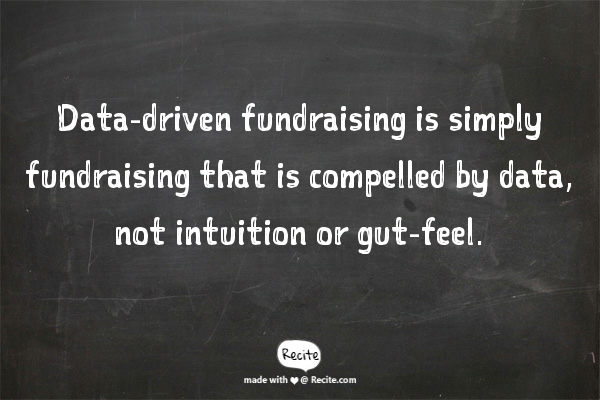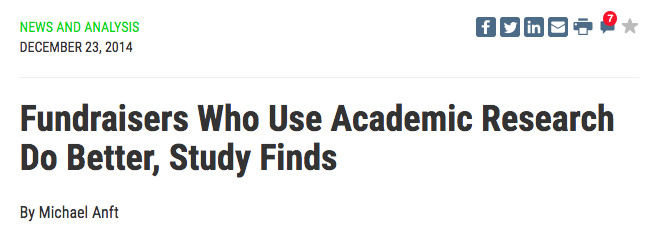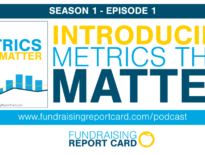You don’t have to look far to find an answer. Google search, “Is fundraising an art or a science?” and you’ll be greeted by myriad results.
With industry experts and practitioners on both sides of the fence, it can be hard to decide which one is “right.” Is successful fundraising the result of savvy relationship building skills (the art), or compelling data analysis leading to A/B split tests and “optimization” (the science)?
Read enough blog posts or thought pieces on the topic and you’ll most likely be more confused than you were to begin with.
As more and more organizations adopt “data-driven” mindsets it can be difficult to rely on traditional “gut-feel” approaches to fundraising. More frequently than not leadership wants “metrics,” and “data” to validate where budget will be spent.
Does this shift in thinking mean that fundraising is more science than art? I don’t think so. It could be that the entire argument is actually broken. Successful fundraising relies on neither art nor science to perform its best. Let’s add another phrase to the conversation: evidence-based.
Evidence-based practice
Evidence-based practice is a phrase used to describe the application of a specific set of steps to any situation. Healthcare research relies heavily on evidence-based practice, and a quick google search will have you diving head first into the proper questioning techniques for public health studies.
However, in our field, we have historically avoided such rigorous and scrutinized questioning to determine outcomes. Fundraising has traditionally been perceived as “unscientific.” (Obviously it is not, and a lot of research exists to support that, but anecdotally that sentiment feels “true.” Think for a moment about the divide between prospect research and gift officer. One (the gift officer) perceives that other (the researcher) is too “research” focused, while the other (the researcher) is convinced that their counterpart (the gift officer) could benefit from more research).
“People give because they love the feeling,” you’ll read online. And yes, some research does back this up, but how does this play into our sector’s discussion of art vs. science in order to raise more dollars? And, more pressing, how should this shape the sentiment of board members, executive directors, and those in leadership positions? Are they justified in wanting to dig deeper into the numbers?
Applying evidence-based practices (EBP) simply means that you question something, test that something, and observe the outcome of your test.
That would make evidence based fundraising as simple as saying, “I wonder if more people will donate to our e-campaign on a Tuesday than they would on a Wednesday?” You would then send an e-campaign to half of your list on Tuesday and the other half the next day. To conclude, you would compare how many dollars were raised on each day and answer your initial question.
That is evidence-based fundraising.
The beautiful thing about evidence-based approaches is that they are applicable in any situation. If you want to make an argument that fundraising is more of an art, more power to you, you can still leverage EBP to further your justification. You can do the same on the science end of the spectrum as well.
Whether that be testing the effectiveness of schmoozing with a major donor prospect, or A/B split testing your annual appeal letter — in either situation you can use EBP to justify and support the outcome.
Evidence-based practice simply forces you to test something. Without testing and measuring outcomes you would rely on anecdotal, or gut-feel approaches. EBP gives you a way to further validate the things that you think work, or expose you to alternatives that might not have been implemented in the past.
Data-driven fundraising
Evidence-based practices lead us to data-driven fundraising. If you travel to a conference, or attend a webinar on “data” at some point in 2018 you’ll most likely hear the phrase “data-driven fundraising.” Don’t fret, you already know what it is.
Data-driven fundraising is simply the application of evidence-based practices. Think about our “schmoozing with a major donor prospect” scenario again. We can apply evidence-based practices to this interaction, and ultimately create a data-driven plan for how to interact with major donor prospects in the future.
For example, at a higher education institution, a major gift officer could have the hypothesis that giving a major gift prospect a tour of the basketball stadium and locker room would increase their likelihood to purchase season tickets, or make a major contribution.
This MGO would test that hypothesis by giving some prospects tours, and others not. After a few weeks or months of recording data she could analyze the results and begin to make some sort of conclusion with regards to her initial hunch. Did those who received the tour give more or sign on for season tickets at a greater rate than the others?
This is evidence-based practice, and it is also data-driven fundraising.
A Chronicle of Philanthropy article from 2014 makes this argument even more clear. It reads;
She [Edith Dobrez, executive director of the Science of Philanthropy Institute] encourages groups of all sizes to not only use studies conducted by academic researchers, but to design their own experiments as well, perhaps by offering several types of fundraising approaches at the same time and then measuring the results of each.
This concept is not new (far from it), but seems relatively foreign in our sector.
Applying this at your shop
I talk with a lot of nonprofit professionals, hundreds, if not thousands each year. It’s always surprising to me to hear so many talk about “predictive models,” and “diving into the data.”
Art vs. science, science vs. art, it doesn’t matter what side of the fence you are on, what we need to get behind is evidence-based. Try experimenting at your shop. Share this article with leadership who insists on being too scientific (i.e. spending way too much budget on a predictive model thing that will simply “sit on the shelf”).
Remember how to apply evidence-based practices, and use them as frequently as you can. The more you test and learn, the better off you, and your organization will be.







